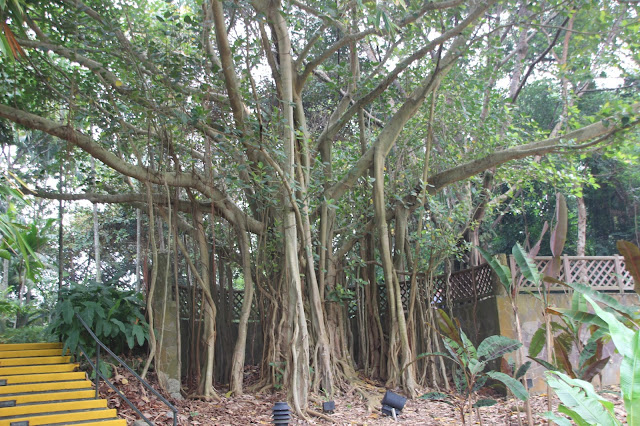After germination, these figs anchor themselves to the canopy of the tree before sending down their aerial roots that eventually create an anchor in the ground, competing with the host tree for nutrients and eventually strangling it to death. The formation of these roots creates the familiar and unique interweaving pattern that is specific to each individual tree. Older banyan trees establish aerial prop roots that grow into thick woody trunks which can become indistinguishable from the main trunk. This can mean that old trees can spread out laterally, with these prop roots to cover a very wide area. Their longevity and spreading nature gives rise to many well known myths in both Malaysia and India. India is home to the world's biggest Banyan in the Botanic Gardens near Kolkata. It was the widest tree in the world in terms of the area of the canopy and is estimated to be about 1200 to 1250 years old. It became diseased after it was struck by lightning, so in 1925 the middle of the tree was excised to keep the remainder healthy; this has left it as a clonal colony, rather than a single tree. A 330 metre long road was built around its circumference, but the tree continues to spread beyond it. We have some big ones in our Botanic Gardens here too which we went to see on Friday.
As well as its unique beauty, the Banyan is a principle rainforest species that is an important food source to many animals including bats, birds and mammals who depend on it for survival, especially during lean times in the forest. The mesh of roots growing around the support tree eventually kills the host tree which eventually rots away so that the banyan becomes a "columnar tree" with a hollow central core. In the forest these hollows provide shelter for animals but they also make for great imaginative tree-houses for kids.
It is not surprising though, that the cultivation of Banyan Trees in Singapore is generally frowned upon for infrastructure reasons. Even though they provide an abundance of shade, their numerous roots cause frequent cracks in the ground, while the large number of flowers, fruits and subsequent animal droppings often requires the regular attention of cleaners. As a result, you generally only get to appreciate the natural wonders of a Banyan Tree in large scale public areas, nature reserves or parks in Singapore. It's their unique form that intrigues me, but at the same time it's a good thing we had the one growing in our backyard in Tiwi removed by Luke and Co. back in 2013.





No comments:
Post a Comment